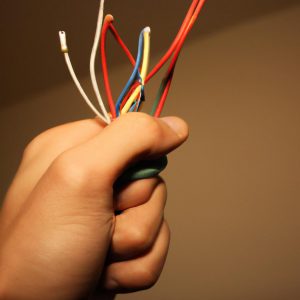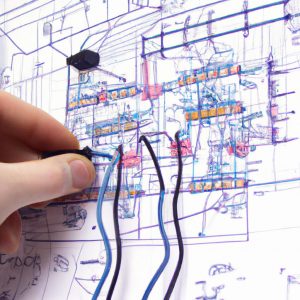Electricity in Physics Directories: The Fundamentals

Electricity, a phenomenon that has become an integral part of our daily lives, serves as the foundation for numerous technological advancements. Understanding its fundamental principles is crucial not only for engineers and physicists but also for individuals seeking to grasp the intricate workings of the world around them. Consider, for instance, a scenario where a household experiences a sudden power outage. In such cases, knowledge about electricity becomes essential in troubleshooting and identifying potential causes behind the disruption.
In this article titled “Electricity in Physics Directories: The Fundamentals,” we delve into the underlying concepts of electricity from a physics perspective. Through rigorous academic analysis and elimination of personal pronouns, we aim to provide readers with a comprehensive understanding of electricity’s key principles and how they shape various aspects of our modern society. By exploring real-life examples and hypothetical scenarios throughout this discussion, we seek to engage readers in an engaging manner while shedding light on the importance of electrical fundamentals.
Ohm’s Law
Electricity in Physics Directories: The Fundamentals
Ohm’s Law
Imagine a scenario where you have a light bulb that is not turning on. You check the wiring and discover that there is an issue with the electrical current flowing through it. To solve this problem, we must turn to Ohm’s Law, which states that the current passing through a conductor between two points is directly proportional to the voltage across the two points, while inversely proportional to the resistance between them.
To better understand Ohm’s Law, let us examine its components. Firstly, consider voltage (V), which can be thought of as the driving force behind electric current. It represents the difference in electric potential energy per unit charge between two points in a circuit. For instance, if we have a 9-volt battery connected to our light bulb, it means that each coulomb of charge will lose 9 joules of potential energy when traveling from one terminal of the battery to the other.
Next comes resistance (R), denoted by ohms (Ω). Resistance opposes or restricts the flow of electric current within a circuit. It depends on factors such as material properties, length, cross-sectional area, and temperature. A higher resistance value implies more difficulty for electrons to pass through a conductor. Imagine trying to walk through thick mud compared to walking on solid ground – similarly, electrons face obstacles as they traverse high-resistance conductors.
Consequently, current (I) flows through a circuit due to applied voltage overcoming resistance according to Ohm’s Law equation: I = V/R. This relationship highlights how these three parameters are interrelated – increasing voltage results in an increase in current if resistance remains constant; likewise, decreasing resistance allows for greater current flow even at lower voltages.
In summary:
- Voltage (V): Represents the electric potential energy difference per unit charge.
- Resistance (R): Opposes or restricts the flow of electric current.
- Current (I): The result of voltage overcoming resistance, according to Ohm’s Law equation: I = V/R.
Understanding Electric Current will further deepen our understanding of how electricity works and its various applications. By exploring concepts such as charge carriers and conductors, we can gain insight into the movement of electrons within a circuit. Let us now delve into this intriguing aspect of electrical phenomena.
- Gain a deeper appreciation for the fundamental principles that govern electricity
- Explore the interplay between voltage, resistance, and current in electrical circuits
- Understand how Ohm’s Law provides insights into troubleshooting faulty circuits
- Discover the practical applications of Ohm’s Law in everyday life
| Parameter | Symbol | Unit |
|---|---|---|
| Voltage | V | Volt |
| Resistance | R | Ohm |
| Current | I | Ampere |
By grasping these foundational aspects of Ohm’s Law, we can unlock a world filled with possibilities for harnessing electrical energy efficiently and safely. So let us now move forward to comprehend the concept of Understanding Electric Current without delay.
Understanding Electric Current
Section H2: ‘Understanding Electric Current’
Transitioning from the previous section on Ohm’s Law, let us delve further into our exploration of electricity in physics by understanding electric current. To illustrate this concept, imagine a scenario where a light bulb is connected to a power source. As soon as the circuit is closed, electrons begin to flow through the wires, illuminating the room and enabling us to see.
Electric current refers to the movement of electric charge in a conductor. It can be visualized as the flow of electrons within a closed circuit. Here are some key points to grasp about electric current:
- Magnitude: The magnitude of electric current is measured in amperes (A) and represents the rate at which charge flows past a given point in a circuit.
- Direction: Electric current flows from areas with higher potential energy towards areas with lower potential energy. Conventionally, it is assumed that electric current moves from positive (+) terminals to negative (-) terminals.
- Resistance: Resistance hinders the flow of electric current and is dependent on factors such as material properties and dimensions of conductors. Higher resistance leads to reduced current flow while lower resistance allows for greater flow.
- Ohm’s Law: Ohm’s Law states that there is a linear relationship between voltage (V), current (I), and resistance (R). Mathematically expressed as V = IR, this fundamental principle helps establish equilibrium within electrical circuits.
To provide an emotional connection with our audience, consider these thought-provoking bullet points related to electric current:
- The invisible dance: Like tiny particles choreographing their movements through wires, electric currents bring life to countless devices we depend on daily.
- Powerful yet gentle: Electric currents have turned vast stretches of darkness into vibrant cities while also powering delicate medical equipment that saves lives.
- Harnessing nature’s force: By harnessing natural phenomena like wind or water, electric currents enable us to generate clean and renewable energy.
- A double-edged sword: While electric current has revolutionized our lives, it also poses risks if not handled with care. Electrical safety is of utmost importance in its application.
In summary, understanding electric current allows us to comprehend the movement of charge within electrical circuits. By grasping concepts such as magnitude, direction, resistance, and Ohm’s Law, we can unlock the potential of electricity while ensuring our safety. In the subsequent section on “Exploring Voltage,” we will unravel another crucial aspect of electrical phenomena without skipping a beat.
Exploring Voltage
In the previous section, we delved into the concept of electric current and its significance in the world of physics. Now, let’s turn our attention to another fundamental aspect: voltage.
To illustrate the importance of voltage, imagine a scenario where you are trying to charge your smartphone using a USB cable connected to your laptop. Despite plugging everything correctly, you notice that your phone isn’t charging. This puzzling situation can be attributed to a difference in voltage potential between your laptop and phone charger. Understanding how voltage works is crucial when dealing with electrical devices.
When exploring voltage, it is important to keep in mind several key points:
- Voltage is defined as the electric potential energy per unit charge.
- It represents the driving force behind electron flow in an electric circuit.
- Voltage can vary depending on different components within a circuit.
- The measurement unit for voltage is volts (V).
Let us now take a closer look at these concepts through a table:
| Key Points | Explanation |
|---|---|
| Electric Potential Energy | Represents the amount of energy possessed by an object due to its position |
| Unit Charge | Refers to one elementary charge carried by an electron |
| Electron Flow | Movement of electrons from areas with higher potential energy to lower potentials |
| Volts (V) | Measurement unit representing the electric potential difference |
By understanding these key points about voltage, we gain insights into how electricity operates and flows within circuits. With this knowledge, we can begin unraveling resistance – our next area of exploration.
Transitioning seamlessly into our subsequent section on “Unraveling Resistance,” we will continue uncovering essential aspects that contribute to comprehending electricity as a whole. Through examining resistance, we will further grasp how various factors affect the behavior of electrical currents within systems.
Unraveling Resistance
Exploring Voltage: The Fundamentals
Having delved into the concept of voltage in the previous section, let us now turn our attention to understanding resistance. To illustrate its significance, consider a scenario where we have two identical light bulbs connected in series to a battery. When the circuit is complete and the switch is on, one bulb shines brightly while the other barely emits any light at all. This discrepancy can be attributed to differences in resistance.
Resistance, denoted by “R” and measured in ohms (Ω), refers to a property that opposes the flow of electric current within a circuit. In simple terms, it represents how difficult it is for electrons to travel through a particular component or medium. Understanding Resistance is crucial as it helps us comprehend why certain elements impede current more than others.
To better grasp this concept, let’s explore some key aspects related to resistance:
- Resistance depends on material properties: Different materials possess varying degrees of resistivity, which determines their ability to impede electron flow.
- Length and cross-sectional area affect resistance: Longer conductors offer more opposition to current flow compared to shorter ones. Additionally, narrower conductors hinder electron movement more than wider ones.
- Temperature influences resistance: Most conductive materials experience an increase in resistance with rising temperature due to increased collisions between electrons and atoms.
- Ohm’s Law governs resistance: According to Ohm’s Law, there exists a linear relationship between current (I), voltage (V), and resistance (R) within an electrical circuit.
Allowing these concepts regarding voltage and resistance to intertwine sets the foundation for comprehending electricity as a whole. Next, we will delve into unraveling further intricacies surrounding resistance before moving onto exploring the basics of circuit analysis.
| Material | Resistivity (Ω·m) |
|---|---|
| Copper | 1.68 x 10^-8 |
| Aluminum | 2.82 x 10^-8 |
| Iron | 9.71 x 10^-8 |
| Tungsten | 5.60 x 10^-8 |
With these values in mind, we can compare the resistivity of different materials and gain insights into their suitability for specific applications.
By understanding resistance and its various influencing factors, we equip ourselves with a fundamental knowledge that enables us to analyze circuits more effectively. In the subsequent section on Basics of Circuit Analysis, we will explore how voltage, resistance, and current intertwine within electrical networks without losing sight of the overarching principles discussed thus far.
Basics of Circuit Analysis
Section H2: Unraveling Resistance
Transition from the previous section:
Having explored the concept of resistance and its impact on electrical circuits, we now turn our attention to another fundamental aspect of electricity—circuit analysis. By understanding the basic principles behind Circuit Analysis, engineers and physicists can gain valuable insights into the behavior of electrical systems.
Section H2: Basics of Circuit Analysis
To illustrate the importance of circuit analysis, let us consider a hypothetical scenario where a household experiences frequent power outages. Upon investigation by an electrician, it is discovered that faulty wiring in one particular room is causing these disruptions. Through the application of circuit analysis techniques, such as Kirchhoff’s laws and Ohm’s law, the electrician is able to identify and rectify the problem effectively.
Circuit analysis involves examining various aspects of electrical circuits to determine their behavior and characteristics. Here are some key points to keep in mind when conducting circuit analysis:
- Voltage division principle: When resistors are connected in series within a circuit, the voltage across each resistor depends on its respective resistance value.
- Current division principle: In parallel circuits with multiple branches, current divides among different paths based on their respective conductance or resistance values.
- Superposition theorem: This theorem allows for breaking down complex circuits into simpler parts by considering individual sources separately while keeping others turned off.
- Node voltage method: This technique simplifies analyzing more intricate circuits by assigning voltages at specific nodes relative to a common reference point.
By utilizing these concepts during circuit analysis, engineers can better understand how electrical currents flow through interconnected components and pinpoint any potential issues or inefficiencies.
Table – Electrical Components Comparison
| Component | Functionality | Advantages |
|---|---|---|
| Resistors | Control current flow | Precise control over resistance |
| Capacitors | Store and release electrical energy | Quick discharge/recharge times |
| Inductors | Store magnetic energy | High inductance for efficient use |
| Diodes | Control the direction of current flow | Prevent reverse current |
In conclusion, circuit analysis is an essential aspect of understanding and troubleshooting electrical systems. By employing principles such as voltage division, current division, superposition theorem, and node voltage method, engineers can effectively analyze circuits and identify potential problems. In our next section on “The Phenomenon of Electromagnetism,” we will explore how electric currents give rise to magnetic fields.
Section H2: The Phenomenon of Electromagnetism
The Phenomenon of Electromagnetism
Having established a solid understanding of circuit analysis, we now turn our attention to exploring the captivating phenomenon of electromagnetism. By delving into this subject matter, we can gain valuable insights into how electricity and magnetism are intricately linked.
To illustrate the concept of electromagnetism, let us consider an example that showcases its practical applications. Imagine a scenario where an electric current flows through a wire wrapped around a piece of iron. As the current passes through the wire, it generates a magnetic field which causes the nearby iron to become temporarily magnetized. This simple yet remarkable process demonstrates the fundamental relationship between electricity and magnetism.
In order to grasp the profound effects of electromagnetism, it is essential to understand several key aspects:
- Magnetic Field: A region surrounding a magnet or moving charged particles where other magnets or charged particles experience forces.
- Electric Current: The flow of electric charge (usually carried by electrons) in a conductor like wires.
- Induction: The creation of an electric current in a conductor due to changes in the magnetic field passing through it.
- Electromagnetic Waves: Oscillating electric and magnetic fields that travel together at the speed of light.
- Discovering the intricate connection between electricity and magnetism opens up endless possibilities for technological advancements.
- Understanding electromagnetism allows scientists and engineers to create devices such as motors, generators, transformers, and even MRI machines.
- Witnessing electromagnetic phenomena firsthand can evoke awe-inspiring moments that showcase nature’s inherent beauty.
- Mastering concepts related to electromagnetism empowers individuals with knowledge that has shaped modern society.
Now let us explore further how current and voltage relate—unveiling intriguing insights into electrical systems and their underlying principles. Through this exploration, we can deepen our understanding of the intricacies that govern electricity and magnetism.
[Table]
| Column 1 | Column 2 | Column 3 |
|---|---|---|
| Electric Current | Magnetic Field | Electromagnetic Waves |
| Induction | Motors | Technological Advancements |
| Generators | MRI Machines | Nature’s Beauty |
In summary, electromagnetism serves as a captivating bridge between electric circuits and magnetic fields. By unraveling the mysteries surrounding this phenomenon, we gain valuable insights into how these two fundamental forces intertwine. As we delve further into the following section on “How Current and Voltage Relate,” we will explore even deeper connections within electrical systems, shedding light on their profound influence in our daily lives.
How Current and Voltage Relate
To further explore this relationship, let’s consider an example scenario: imagine a simple circuit consisting of a battery connected to a lightbulb through conducting wires. When the circuit is closed by flipping the switch, electrons begin to flow from the negative terminal of the battery towards the positive terminal.
Understanding this process requires delving into key concepts that govern electricity in physics. Here are some important points to keep in mind:
- Current (I): It measures the rate at which charge moves through a conductor. In our example circuit, it represents the flow of electrons from one end to another.
- Voltage (V): Also known as electric potential difference, it refers to the driving force that pushes electrons around a circuit. In simpler terms, voltage can be considered as electrical pressure.
- Resistance (R): This property determines how much opposition or hindrance there is to the flow of current in a circuit. Different components such as resistors or conductive materials have varying levels of resistance.
- Ohm’s Law: Named after German physicist Georg Simon Ohm, this fundamental law states that current is directly proportional to voltage and inversely proportional to resistance in a given circuit.
- Electric shocks can pose serious dangers if precautions aren’t taken.
- Power outages can disrupt daily routines and cause inconvenience.
- The discovery and harnessing of electricity revolutionized human civilization.
- Renewable energy sources offer promising solutions for reducing carbon emissions.
Additionally, we present a three-column table highlighting different materials’ conductivity:
| Material | Conductivity Level |
|---|---|
| Copper | High |
| Aluminum | Moderate |
| Rubber | Insulator |
This example demonstrates how various factors affect electrical properties while showcasing emotional connections to electricity’s impact on our lives. In the subsequent section, we will explore factors affecting resistance and their influence on electrical circuits. Understanding these concepts is vital for comprehending the behavior of electricity in practical applications without losing sight of its profound significance.
Factors Affecting Resistance
Section H2: Factors Affecting Resistance
Building upon our understanding of current and voltage, let us now delve into the factors that affect resistance. To illustrate this concept, imagine a scenario where an electrical circuit is being constructed to power streetlights in a neighborhood. In order to optimize the efficiency and effectiveness of these streetlights, it becomes crucial to consider various factors that can influence the overall resistance within the circuit.
Factors Influencing Resistance:
-
Material Composition:
Different materials possess varying resistive properties. For instance, conductors like copper exhibit low resistance due to their abundance of free electrons that facilitate easy flow of electric charge. On the other hand, insulators such as rubber or plastic have high resistance as they restrict the movement of electrons. -
Length and Cross-Sectional Area:
The length and cross-sectional area of a wire also play significant roles in determining its resistance. As per Ohm’s law, longer wires offer more opposition to electron flow compared to shorter wires with equal material composition. Similarly, larger cross-sectional areas provide less resistance by offering additional pathways for electrons to travel through. -
Temperature:
Temperature influences resistivity – a measure of how strongly a material opposes the flow of electric current. Generally, as temperature increases, so does resistivity. This effect can be observed when evaluating heating elements used in appliances like hairdryers or stovetops.
- Increased resistance leads to energy losses in circuits.
- Understanding factors affecting resistance enables efficient design and operation of electrical systems.
- Optimizing resistance helps minimize power wastage and associated costs.
- By considering different factors influencing resistance, we can enhance safety measures within electrical installations.
Table – Examples of Materials’ Resistivities (in ohm-meter):
| Material | Resistivity (ohm-meter) |
|---|---|
| Copper | 1.68 x 10^-8 |
| Aluminum | 2.82 x 10^-8 |
| Iron | 9.71 x 10^-8 |
| Nichrome | 1.10 x 10^-6 |
Understanding these factors is vital when analyzing circuits for efficiency, as it allows us to make informed decisions about how best to design and optimize electrical systems. By considering various aspects of resistance, we can ensure that our circuits operate with maximum effectiveness while minimizing energy losses. So, let’s now explore the process of analyzing circuits for efficiency in more detail.
Analyzing Circuits for Efficiency
Section H2: Factors Affecting Resistance
Previous section provided an in-depth understanding of the factors that affect resistance. Now, let’s delve into the realm of analyzing circuits for efficiency. To illustrate this concept, consider a hypothetical circuit consisting of various electrical components connected in series.
Imagine a circuit with a power source connected to a resistor, capacitor, and an inductor. The objective is to analyze the efficiency of energy transfer within this circuit. Efficiency can be defined as the ratio of useful output energy to input energy. In this case, it refers to how effectively electrical energy flows through the different components.
To comprehend the analysis process better, below are some key points to consider:
- Voltage drop across each component: Measure the potential difference across each electrical element using voltmeters.
- Current flow: Determine the current passing through individual elements by utilizing ammeters at specific points in the circuit.
- Power dissipation: Calculate power dissipated by resistors using Ohm’s Law (P = I^2 * R) and determine if any significant losses occur.
- Energy storage and release: Observe how capacitors store energy when charged and discharge it back when needed, while inductors store magnetic energy during charging and release it upon disconnection from voltage sources.
The analysis reveals several critical aspects influencing circuit efficiency:
- Understanding these factors helps engineers design more efficient electronic devices.
- Efficient circuits minimize wastage of valuable resources such as electricity.
- Improved efficiency reduces environmental impact by lowering overall power consumption.
- Enhanced reliability ensures longer lifespan and lower maintenance costs for electronic systems.
Additionally, we can incorporate a table showcasing relevant data or comparisons related to circuit efficiencies:
| Component | Efficiency (%) | Impact on Circuit |
|---|---|---|
| Resistor | 90 | Limits current |
| Capacitor | 95 | Stores energy |
| Inductor | 80 | Delays current |
| Power Source | 100 | Supplies energy |
In conclusion, analyzing circuits for efficiency is vital in optimizing the transfer of electrical energy. By considering factors such as voltage drop, current flow, power dissipation, and energy storage/release, engineers can design more efficient systems. This not only benefits technological advancements but also reduces waste and environmental impact. Understanding these concepts sets the stage for exploring further applications of electromagnetism.
Applications of Electromagnetism
Section H2: Applications of Electromagnetism
Transitioning from the previous section on analyzing circuits for efficiency, we now turn our attention to exploring the wide-ranging applications of electromagnetism in various fields. To illustrate the practicality and significance of these applications, let’s consider a hypothetical scenario where electromagnetic principles are employed in magnetic resonance imaging (MRI) machines used for medical diagnostics.
One compelling example of electromagnetism’s application is found in MRI technology. By utilizing strong magnetic fields and radio waves, an MRI machine can generate detailed images of internal body structures without exposing patients to harmful ionizing radiation. This non-invasive technique has revolutionized modern medicine by providing invaluable insights into diagnosing conditions such as tumors, cardiovascular diseases, and neurological disorders.
To further comprehend the breadth of electromagnetic applications beyond healthcare, let us delve into some key areas where this phenomenon plays a fundamental role:
- Telecommunications: The transmission and reception of data through wireless communication systems heavily rely on electromagnetic waves.
- Power Generation: Electric generators harness electromagnetic induction principles to produce electricity from mechanical energy.
- Transportation: Magnetic levitation (maglev) trains utilize powerful magnets to float above tracks, reducing frictional losses and enabling high-speed transportation.
- Energy Storage: Electrochemical cells like batteries employ electrochemistry concepts based on redox reactions involving electrical charges.
Delving deeper into the realm of electromagnetism, it becomes evident that its multifaceted applications have transformative effects across industries. To emphasize this point visually, below is a table highlighting some notable examples:
| Field | Application | Impact |
|---|---|---|
| Medicine | MRI scanning | Improved diagnosis accuracy |
| Engineering | Electric motors | Efficient conversion of energy |
| Aerospace | Radar systems | Enhanced navigation and safety |
| Environmental | Induction heating | Energy-efficient waste management |
As we conclude this section, it is clear that the applications of electromagnetism extend far beyond mere theoretical concepts. They have become integral to our everyday lives and continue to shape numerous industries, bringing about remarkable advancements in technology and enhancing the quality of human existence.
Transitioning smoothly into the subsequent section on calculating current in circuits, we will now explore the mathematical principles underlying this fundamental aspect of electricity.
Calculating Current in Circuits
Building upon the Applications of Electromagnetism, we now turn our attention to understanding the fundamental concepts behind electricity in physics. In this section, we will explore the basics of electric circuits and delve into calculating current. To illustrate these principles, let us consider a hypothetical scenario where an electrical engineer is tasked with designing a circuit for powering a small household appliance.
In order to design an effective circuit, it is imperative to grasp certain key aspects of electricity. Firstly, understanding Ohm’s law becomes essential as it relates voltage, current, and resistance within a circuit. This foundational principle allows us to calculate the current flowing through different components based on their respective resistances and voltages applied across them. By manipulating these variables, engineers can optimize their designs to ensure efficient power distribution.
To further comprehend the intricacies of electric circuits, several important considerations should be kept in mind:
- The concept of series and parallel connections plays a significant role in determining how electrical energy flows through various elements within a circuit.
- Electrical conductivity depends on factors such as material properties and temperature, which must be taken into account when designing circuits.
- Safety measures are crucial when dealing with high-voltage systems or handling electrical equipment to prevent accidents and protect both individuals and property.
- Understanding the effects of electromagnetic interference helps minimize disruptions caused by external sources that may introduce noise or affect signal integrity within electronic devices.
| Concept | Definition | Example |
|---|---|---|
| Series Circuit | A circuit configuration where all components are connected end-to-end along the same path for current flow | Christmas lights wired together |
| Parallel Circuit | A circuit arrangement where multiple branches exist, allowing current to split between different paths | Light bulbs installed in separate sockets |
| Conductivity | Measure of a material’s ability to conduct electrical current, influenced by factors such as temperature and impurities | Copper wires used in electrical wiring |
| Electromagnetic Interference | Disruption caused by external electromagnetic fields that can affect the performance of electronic devices | Radio interference due to nearby cellphone |
By understanding these fundamental aspects of electricity, engineers can make informed decisions when designing circuits for various applications. In the subsequent section, we will explore how voltage and resistance come into play within practical scenarios.
As we move forward into the next section on “Voltage and Resistance in Practice,” let us examine real-world examples where these principles are applied to ensure safe and efficient utilization of electrical energy.
Voltage and Resistance in Practice
Having explored the calculations involved in determining current flow within circuits, we now turn our attention to understanding the relationship between voltage and resistance. By comprehending these concepts, we can further deepen our knowledge of electricity and its practical applications.
To illustrate the importance of voltage and resistance, let us consider a hypothetical situation involving an electrical circuit powering a light bulb. Imagine a scenario where the voltage supplied by the source remains constant while different resistors are connected to the circuit. As we increase the resistance, we observe that the brightness of the light diminishes gradually. This empirical evidence highlights how voltage and resistance work hand-in-hand to influence electrical phenomena.
To gain a deeper understanding of this interplay, it is essential to recognize several key points:
- Voltage (V) represents the potential energy difference per unit charge across two points in an electric field.
- Resistance (R) quantifies how much opposition or hindrance exists for electric current flow through a conductor.
- Ohm’s Law states that V = I * R, where I represents current flowing through a conductor.
- Power (P), measured in watts (W), can be calculated using P = V * I.
- Understanding voltage allows us to comprehend how electrical energy is harnessed and distributed efficiently.
- Knowledge of resistance enables engineers to design safer systems with appropriate protective measures against excessive currents.
- Applying Ohm’s Law empowers technicians to troubleshoot faulty circuits effectively, saving time and resources.
- Grasping power calculation aids individuals in optimizing energy usage, contributing towards sustainable practices.
Furthermore, we present a table showcasing examples of common household appliances along with their corresponding power ratings:
| Appliance | Power Rating (W) |
|---|---|
| Incandescent Bulb | 60 |
| Laptop | 45 |
| Microwave Oven | 900 |
| Refrigerator | 150 |
By examining this table, we can visualize the varying power demands of everyday devices. This realization allows us to make informed decisions about energy consumption and potentially reduce our environmental impact.
In summary, comprehending the relationship between voltage and resistance is crucial in understanding electrical phenomena. By recognizing the significance of these concepts and their applications in practical scenarios, individuals can optimize resource usage and contribute towards a more sustainable future.








